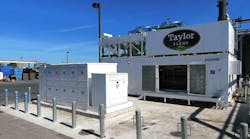Today’s power grid isn’t what it used to be, as more companies in the industrial and commercial settings want to produce their own power to help control costs and environmental impacts. The rise in distributed energy resources allows users to supply their own power, especially in remote locations where they may not have been able to reach the traditional power grid.
Moving off grid to a microgrid can take many forms. One approach that creates long-term viability for a microgrid is to use a diverse mix of energy generating sources. Today’s renewable energy sources like solar and wind provide intermittent power, requiring backup generation via fossil fuels to ensure seamless and consistent power at all times. Over the next 30-40 years however, we will see these fossil fuels being phased out, as other renewable energy resources like biogas and the use and deployment of batteries help companies transition to 100 percent clean energy.
Load Balancing
Load balancing uses various techniques to create a nest egg of power during low demand periods for later release when power demand increases. Artificial Intelligence (AI) and machine learning (ML) will play a critical role in allowing us to leverage load balancing strategies and realize in advance when more power may be required. While some usage spikes are more predictable, such as during storms or after a typical working day, technologies like ML and AI allow us to predict the less obvious and manage energy resources more efficiently.
Software with intelligent controls and algorithms can take advantage of ML and AI integration, allowing us to integrate with renewable energy resources and bring cogeneration into the next wave of sustainable infrastructure.
Dispatchable Distributed Energy Resources
The investment gap in energy infrastructure to keep pace with growing energy demand is estimated to be $177 billion. To help bridge this gap, we will rely on a new wave of dispatchable distributed energy resources like cogen and batteries for optimizing energy usage and providing more reliable power. At the power plant level, machine learning and AI techniques can help one or more DERs to adapt to its environment by predicting renewable energy generation patterns, offering a sustainable infrastructure with firm power for the energy grid of the future.
As the incumbents, the current utility companies must either be willing to adopt a more cooperative approach, shepherding in a new era of sustainability. What some may call an energy crisis, I consider it to be an "identity" crisis for utilities. This isn’t a small issue as the relationship between utilities, energy consumers, and energy technology providers continues to evolve.
Energy Independence and Deriving Energy Solely from 100% Renewables
These are not mutually exclusive categories. As more companies move toward energy independence, it is possible to incorporate sustainable elements into today’s grid, while also future-proofing for what’s to come. Generating energy from renewable resources certainly helps a company move toward energy independence. The intermittent nature of renewable energy means there has to be access to a firm power source.
It’s also important to consider that companies who've achieved energy independence can return energy to the grid.
The Most Critical Components
The most critical developments won’t come in the form of hardware or wiring. AI and machine learning will be the most critical components of a sustainable energy infrastructure, especially as these technologies can anticipate (and remediate) issues across the grid and individual microgrids. I believe there will be a series of microgrids in the near term, which will have fallback and failsafe options that rely on other grids.
Predictions
We are heading down a path that encourages microgrid systems and DERs to join sustainability, intelligence and flexibility. I predict they will play a significant role in bringing sustainable infrastructure together with firm power to create a well-balanced grid of the future. Pushing the envelope with today’s technologies to transform tomorrow’s business models will make way for game-changing shifts in the energy story market in the years to come.
Brian Curtis is CEO and Co-Founder of Concentric Power and has more than 20 years of engineering, finance and strategic management experience in energy and high-growth technology industries. Brian founded Concentric Power in 2011 to create sustainable infrastructure and energy independence for companies in critical industries, including food and pharmaceuticals.

